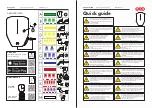
TRAILER SWAY CONTROL
WARNING:
Turning off trailer sway control increases the risk of
loss of vehicle control, serious injury or death. Ford does not
recommend disabling this feature except in situations where speed
reduction may be detrimental (such as hill climbing), the driver has
significant trailer towing experience, and can control trailer sway and
maintain safe operation.
Note:
This feature does not prevent trailer sway, but reduces it once it
begins.
Note:
This feature cannot stop all trailers from swaying.
Note:
In some cases, if vehicle speed is too high, the system may turn
on multiple times, gradually reducing vehicle speed.
This feature applies your vehicle brakes at individual wheels and, if
necessary, reduces engine power. If the trailer begins to sway, the
stability control light flashes and the message
TRAILER SWAY
REDUCE SPEED
appears in the information display. The first thing to
do is slow your vehicle down, then pull safely to the side of the road and
check for proper tongue load and trailer load distribution. See the
Load
Carrying
chapter for specific loading information.
RECOMMENDED TOWING WEIGHTS
Note:
Do not exceed the trailer weight for your vehicle configuration
listed in the chart below.
Note:
Make sure to take into consideration trailer frontal area. Do not
exceed:
•
36.5 feet
2
(3.39 meters
2
) trailer frontal area for vehicles equipped
with the standard towing package.
•
60.0 feet
2
(5.57 meters
2
) trailer frontal area for vehicles equipped
with the optional heavy duty package.
Note:
Exceeding this limitation may significantly reduce the
performance of your towing vehicle. Selecting a trailer with a low
aerodynamic drag and rounded front design helps optimize performance
and fuel economy.
Note:
For high altitude operation, reduce the gross combined weight by
2% per 1000 feet (300 meters) starting at the 1000 foot (300 meter)
elevation point.
Towing
249
2015 Expedition
(exd)
Owners Guide gf, 1st Printing, July 2014
USA
(fus)
















































